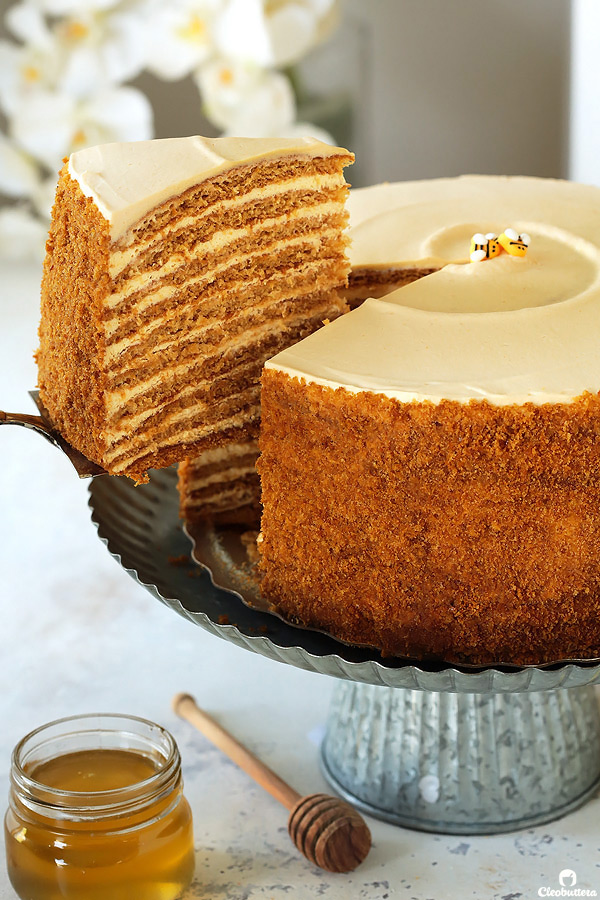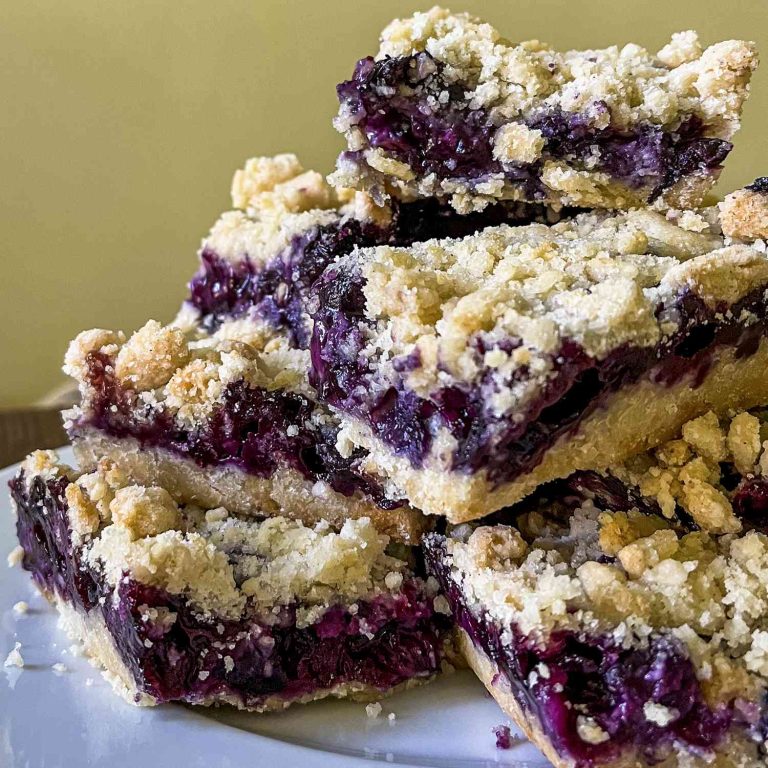Russian Honey Cake Recipe
Russian Honey Cake, or Medovik, dates back to the early 19th century. Legend has it that the cake originated in the imperial kitchen of Russian Tsar Alexander I. One of his chefs created the dessert to impress the Tsarina, who initially disliked honey but loved the cake. This sweet delight soon became a staple in Russian households, symbolizing warmth and tradition. The cake’s layers of honey-flavored goodness combined with creamy filling reflect the richness of Russian culinary heritage, making it a cherished treat during celebrations and family gatherings.
Evolution Over Time
Over the years, Russian Honey Cake has undergone various transformations. Initially, the cake featured just a few layers and simple fillings. As baking techniques advanced, bakers began experimenting with ingredients and the number of layers, resulting in numerous versions. Today, some renditions of Medovik boast up to ten layers with fillings like sour cream, custard, and condensed milk. The cake continues to evolve, blending traditional recipes with modern flair while preserving its iconic status in Russian cuisine.
Key Ingredients of Russian Honey Cake
Honey: The Star Component
Honey serves as the centerpiece of Russian Honey Cake. It lends a distinctive flavor and natural sweetness to the dessert. Trace its significance back to the cake’s history when honey was a primary sweetener in Russian kitchens. The choice of honey affects the final taste; rustic varieties (e.g., buckwheat or wildflower) impart a more robust flavor, while lighter varieties (e.g., clover) offer a subtler sweetness.
Importance of Sour Cream in the Layering
Sour cream plays a crucial role in the cake’s layers. Its tanginess balances the sweetness of the honey, creating a harmonious flavor profile. Decide the texture of the cake based on how the sour cream is incorporated; thicker sour cream results in denser layers, while a whipped version yields a lighter texture. You may find variations using dulce de leche or custard, but traditional recipes prioritize sour cream for its authentic taste.
Recipe Breakdown
Step-by-Step Preparation
- Mix the Dough: Combine 3 tablespoons of honey, 1 cup of sugar, and 1 stick of butter in a heatproof bowl. Place over simmering water and stir until melted. Add 2 beaten eggs, 1 teaspoon of baking soda, and 3 cups of flour gradually, mixing until smooth.
- Roll and Bake the Layers: Divide the dough into 8-10 equal portions. Roll each portion into a thin circle on parchment paper. Bake at 350°F for 5-7 minutes or until golden. Allow layers to cool.
- Prepare the Filling: Whip 4 cups of sour cream with 1 cup of powdered sugar until smooth and creamy. Optionally, fold in vanilla extract or lemon zest for added flavor.
- Assemble the Cake: Place a dollop of cream filling on a serving plate. Lay the first cake layer on top, then add a generous amount of filling, spreading evenly. Repeat until all layers are used.
- Finish and Chill: Spread remaining filling over the top and sides of the cake. Crumble any leftover cake pieces and sprinkle them over the cake. Refrigerate for at least 8 hours or overnight for best results.
- Even Thickness: Ensure each dough portion is rolled out evenly to maintain consistent layer thickness. Use a rolling pin with thickness guides if available.
- Proper Cooling: Allow baked layers to cool completely on a wire rack before assembly. This prevents the cream filling from melting.
- Generous Filling: Apply a generous amount of cream filling between layers. The filling absorbs into the layers, enhancing flavor and moisture.
- Attention to Detail: Trim the edges of each layer if necessary to keep the cake’s structure uniform. Save the trimmed pieces for the final crumb decoration.
- Chilling Time: Refrigerate the assembled cake for an extended period. This step is crucial for the layers to soften and the flavors to meld.
Variations of Russian Honey Cake
Regional Differences
Russian Honey Cake, known as Medovik, showcases diversity across regions. In Moscow, the cake usually features rich layers made with ample butter and sour cream. In contrast, regions like Siberia often use more honey, resulting in a stronger honey flavor. In Tatarstan, chefs sometimes incorporate fermented milk products, such as kefir, for a tangier taste. These regional variations highlight the adaptability of the recipe while preserving its traditional essence.
Modern Twists on the Traditional Recipe
Modern chefs have introduced innovative twists to the Russian Honey Cake without altering its core ingredients. Some add spices, like cinnamon or ginger, for an extra kick. Others use flavored fillings, such as hazelnut cream, chocolate ganache, or fruit preserves, to diversify the taste. Vegan versions replace dairy and honey with plant-based alternatives, ensuring the cake remains accessible to more diets. These modern adaptations maintain the cake’s iconic status while offering new flavor experiences.
Serving and Storage Tips
Best Practices for Serving
Serve Russian Honey Cake at room temperature to fully enjoy its rich flavors and soft texture. Remove the cake from the refrigerator at least 30 minutes before serving. Each layer should be distinct and tender, making it easy to slice and serve. Use a sharp, serrated knife for cleaner cuts and to avoid squishing the layers. Complement the cake with a dollop of whipped cream or a scoop of vanilla ice cream for added indulgence. Pair the cake with hot beverages like tea or coffee to enhance its honey undertones.
How to Store Leftovers Effectively
Store leftover Russian Honey Cake in an airtight container to preserve its moisture and flavor. Keep the container in the refrigerator, where it remains fresh for up to one week. For longer storage, consider freezing the cake in individual slices. Wrap each slice in plastic wrap, then place them in a freezer-safe bag. When ready to eat, thaw the slices in the refrigerator overnight. Avoid microwaving to prevent altering the texture.
Conclusion
Embracing the rich history and cultural significance of Russian Honey Cake, or Medovik, allows you to connect with a cherished tradition. Whether you stick to the classic recipe or experiment with modern twists, this cake offers a delightful blend of flavors and textures.
As you master the art of Medovik, you’ll not only impress your guests but also preserve a piece of culinary heritage. Remember to serve it at room temperature for the best experience and store any leftovers properly to enjoy later.
Dive into the world of Russian Honey Cake and make it a staple in your home.





